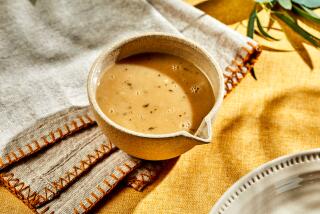Taking the Lumps Out of Gravy
- Share via
Good gravy-- easy words to use as an expletive, but a sauce that many cooks find difficult to prepare. It needn’t be so if you understand the three basic steps: degreasing, deglazing and thickening.
Pan gravy begins with drippings, rendered when meats and poultry are sauteed, broiled, roasted or browned. Once the meat or poultry is cooked, remove it from the pan (Step 1), then degrease the drippings by one of the following methods:
--Pour the juices into a measuring cup designed for this purpose (Step 2), with the pouring spout located near the bottom so the juices may be poured off after the fat rises to the top.
--Tip the pan and use a basting tool to siphon the juices from beneath the fat.
--Pour the juices into a heat-proof glass container and submerge it in cold water so the fat rises to the top and may be spooned off.
Set the fat aside. Add enough water to the remaining drippings to measure two cups (stock, milk, cream, wine or beer may be substituted, if desired). Deglaze the roasting pan by gradually pouring this liquid back into the pan (Step 3), simmering over low heat and scraping up any brown bits off the bottom of the pan with a wooden spoon.
Place three tablespoons of the reserved fat in a saucepan (Step 4). Sprinkle three tablespoons flour over the fat and blend into a smooth roux with a wire whisk or wooden spoon (Step 5). Cook over medium heat three to five minutes, stirring occasionally, to rid the flour of its raw starchy taste.
Gradually add the liquid from the roasting pan (Step 6) and simmer, stirring, until the gravy thickens. Continue to simmer about 15 minutes, stirring occasionally and adding more water as necessary. Strain before serving, if desired.

